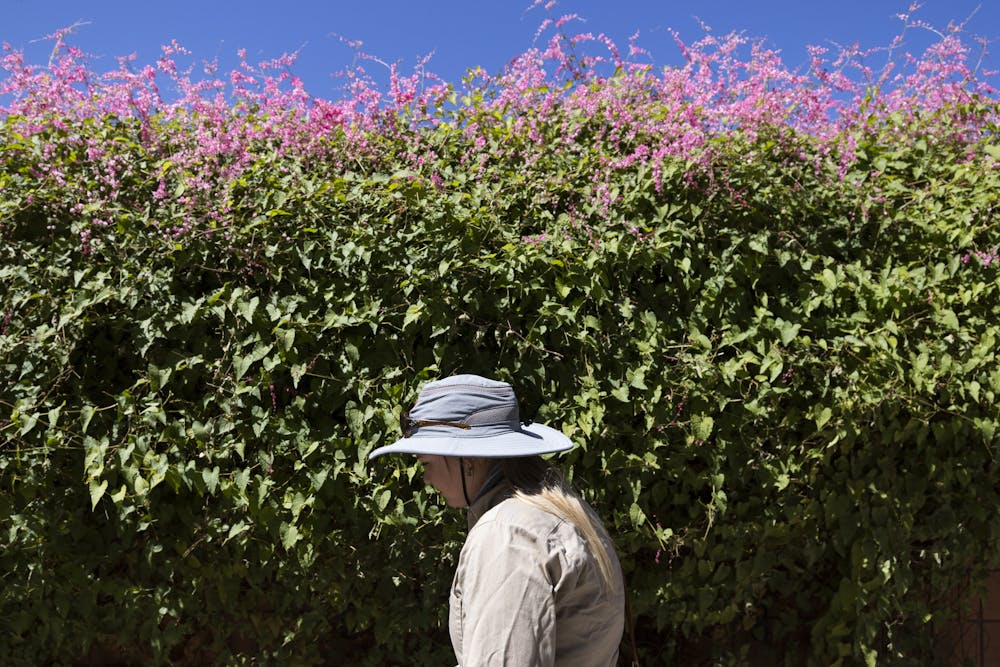Since 1990, ASU has been designated as an Arboretum, a repository of eye-catching, climate-adapted and colorful blooming plants that are easily identified with just a little guidance.
Kendon Jung is a manager in the Facilities Development and Management (FDM) department, which is highly involved in maintaining the Arboretum initiatives.
"The Arboretum covers the entire campus," Jung said. "It's a designation, and different portions of the university's campus will be used in different ways. Sometimes, it depends on the microclimate that is created in these spaces that make it easier to grow one thing over another. But really, the whole campus is part of the Arboretum."
Violet Wielgus is a mapping technician for the FDM and has gathered a collection of flowering plants that can be identified during this time of year.
Sparky (Tecoma)
"Sparkies (have) this particular color combination where it's yellow on the outside, [and] maroon in the center of the corolla," said Wielgus.
Sparkies are a cultivar of the Tecoma genus, meaning that they were selectively bred from other trumpet flowers. They are unique because they were developed and trademarked by ASU, and when these trademarked plants are sold, a small fee is given back to ASU.
Sparkies can be found on Cady Mall, near the construction by Wilson Hall. Other cultivars of Tecomas and their distinct trumpet shape, can be found all over campus.
Queen’s Wreath (Antigonon leptopus)
Queen’s Wreath is identified by its small pink flowers and heart-shaped leaves.
"[It’s] a floral vine native to Mexico's southwest region. It's a really beautiful plant, and it's doing so well in this sunny exposure," Wielgus said.
A large specimen can be found on the wall between Old Main and Durham Hall. People who do not enjoy bees should avoid this plant, as it attracts many pollinators.
While native to Mexico and thriving in Arizona, it is considered an invasive species in eastern states like Florida.
Coral Fountain (Russelia equisetiformis)
Russelia equisetiformis, also known as Coral Fountain or the Firecracker Plant, is a shrub with orange flowers native to Mexico.
"They just have the most incredible fine texture, the most beautiful petite little flowers, and they look like they're cascading like water," Wielgus said.
These plants do well in the sunshine of campus, and several of them can be found outside of the Interdisciplinary Science and Technology Building 10, facing the street on the north side of the building.
Mexican Bird of Paradise (Caesalpinia pulcherrima)
Mexican Bird of Paradise is a shrub known for its bright orange flowers with long stamens and height reaching up to 10 feet in some cases.
"They get enormous, like they can get really big," Wielgus said. "They're native to Mexico. I just think they're really beautiful. They have a really unique flower."
These plants bloom from April through September and October and are located between Interdisciplinary A and B.
This same species is also the national flower of Barbados.
Jimsonweed (Datura stramonium)
Jimsonweed is identified through its large white blooms and spiky seed pods. It has a long history in the Southwest, being used in several indigenous practices, and is poisonous to humans and animals.
Jimsonweed blooms in the late afternoon and night.
"White flowers, in general, reflect the moonlight," Wielgus said. "So if you come out at night and look at this plant when the moon is out, it reflects."
This plant can be found in the Secret Garden. While Jimsonweed is native to the Southwest, the Secret Garden primarily houses exotic and unique plants.
"I would say (the Secret Garden) has more exotic plants than native plants, but they're also just really interesting horticultural specimens," Wielgus said. The plant is no longer in the Secret Garden.
Desert Willow (Chilopsis linearis)
An iconic part of the Arizona landscape, the Desert Willow is not considered a willow tree. Instead, this small tree merely resembles other willows, with silvery leaves and often pink blooms. They bloom during the warmer months.
"They are native to the southwest United States and Mexico," Wielgus said. "See the small, fine texture foliage. The blooms come in a variety of different colors."
They’re commonly used across Arizona in landscaping, so the flowers come in various colors. The light pink variants can be found on Forest Mall and Cady Mall.
These plants, and the hundreds of others on campus, are maintained by a group of around 90 groundskeepers.
"I am in constant awe of how much knowledge all of our incredible groundskeepers have and the way in which they're able to apply that to so many unique species," Jung said. "It is very inspiring to see the level of care that they put into every little plant and the way that they work to create the space that a lot of people take for granted."
Edited by River Graziano, Walker Smith, Shane Brennan
Reach the reporter at syramir2@asu.edu and follow @nerdyoso on X.
Like The State Press on Facebook and follow @statepress on X.
Sophia is a senior studying biological sciences. This is her fifth semester with The State Press. She has also worked as a science and technology reporter.








